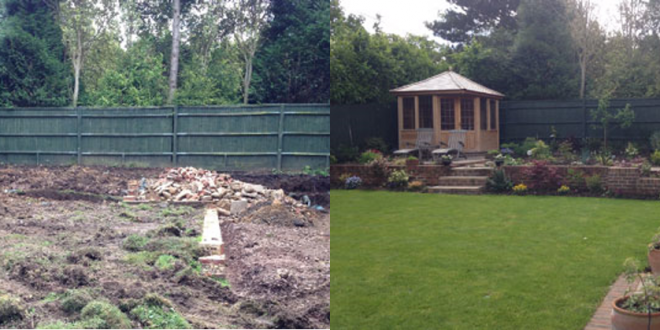Whether you are starting a new garden from scratch, normally the case with a new house, or, what you have is not what you want, re-landscaping is not a task to be undertaken lightly.
Getting Started
Here is our short guide to designing, constructing and planting a new garden.
Before contacting a garden designer or landscaping contractor you need to do your own homework. It’s always wise to do some research, note what you like in gardens you see, visit garden shows and look in magazines or on-line. Once your research is over you can move onto the critical steps to decide what you want and can accommodate in your new garden.
New garden requirements – setting priorities
Typically, the areas required will include;
• Playing and Leisure – lawns, trampolines etc.
• Entertaining and Eating – patios, gravel etc.
• Vegetable patch
• Fruit growing
• Easy maintenance
• Compost and maintenance
• Flower beds
• Trees and shrubs
• Buildings – greenhouses, summer houses, sheds
Think about what you want as days and the seasons progress, will you want seating provision in both the afternoon shade and full sun. As most of us have restricted space, it’s useful to prioritise and to define in square metres, the minimum space required for each, after all, there is no point in a dining area too small for a table and chairs. Now measure up the size of your garden, and after some simple maths, you will have a pretty good idea, of what you can include. If your new to the garden, if feasible, it’s worth taking some time to understand what you have, before starting work.
Before the design stage begins, it is useful to know about;
• Sun direction
• Drainage
• Irrigation
• Soil condition
It’s also wise to think about the sort of design you want, traditional, modern formal, natural or avant-garde etc.
Having now decided what you want and your priorities, you need to set a budget. Invariably as work starts, extra costs are incurred, so it’s worth quoting 10-15% below your maximum to designers, so you have a bit to play with!
Employing a garden designer
You don’t need a large estate to find the services of a garden designer useful. A creative designer can probably help you fit more of your wish list into a restricted space. They are likely to be up to date with current fashions and know where to source features. If you are looking for a Chelsea style garden with a wow factor, unless you are quite talented artistically you will need a professional.
Although the services on offer will vary, often, they will find the landscaper for you, do the project management and, plan and undertake the planting. A useful one-stop shop, but it comes at a price! As with any service, it’s worth speaking to at least three companies. Make sure they understand what you want and that you feel comfortable working with them. They should be able to show you a portfolio of their work, and introduce you to reference customers.
Self-Design
If you have clear ideas on what you want, then self-design is perfectly feasible, after all, most gardens evolve this way. It helps to have input from friends and family. Someone able to put the ideas onto paper will be invaluable and there are on-line design tools available. Once you have prepared you rough design, it is well worth taking your time to review. Mark out orders, paths and walls with a spray marker available from builder merchants. Place objects to represent features, so you have a good idea how it is going to look.
If your garden is on a slope, has drainage issues, large tress or other challenges, it may be worth seeking professional advice just for these. Hard landscaping is expensive and disruptive, so it is essential to get the design right before works starts. Materials such as bricks and paving are permanent so again take your time on deciding what you like, samples are often available so you can judge them at home.
Whether you design your own garden or use a professional, after the plans have been prepared take your time to evaluate them over and over again before moving onto the next step. If you don’t like something change it now, it will be more expensive later.
Landscape Contractors
Most of us will have to use a landscape contractor to turn the design into reality, the physical work required for even a small garden should not be underestimated. The work will involve a number of skills so it’s likely several companies or individual tradesmen will be required, although one normally acts as the lead contractor and manages negotiations. Try to get personal recommendations, if not look at recent local work, ask the homeowner if they would recommend the company they used, always look at reference work. If you use a garden designer, they will normally find a contractor and (at a cost) project manage the day to day issues.
Otherwise, project management is down to you! Although a good contractor will follow the plan and manage the staff, there will inevitably be queries to be discussed and issues to be resolved. It is wise to be handy when this occurs to avoid delays and additional costs.
Be prepared for disruption, mud and endless tea making.
Don’t agree to make final payments until all of the work is completed, make sure soil beds are not full of builder’s rubble, check drains are flowing and that everything is clean and tidy.
Planting a new garden
The choice of planting a new garden is very much down to personal taste. Books abound on the subject of what to plant where for what effect. Garden Centres typically also give good advice. Specialist nurseries have informative websites and many still produce printed catalogues. It is well worth going back to your original plan, overlay it with a planting plan. Do plenty of homework before you start spending and planting.
Some of the key points to remember are;
• Take note of the final plant size. Use this to decide where to plant in a bed, not the physical size when you buy it
• Don’t be tempted to overplant. If the beds look bare in early years, fill the spaces with annuals
• Aim for all season colour, look at the flowering times. Use evergreens to provide winter interest
• Do take note of requirements of sun or soil types. Plants in the wrong location will not thrive
• If you don’t have separate areas, consider including herbs and vegetable areas among your flowers.
Constructing a new garden from scratch is a challenge and quite an investment. An attractive garden increases home values and it saleability, but probably most important, it provides a great place to relax, entertain and have fun.
 Gardeners Club The Gardeners Club is a free to join online club for everyone with an interest in gardening and gardens.
Gardeners Club The Gardeners Club is a free to join online club for everyone with an interest in gardening and gardens.






